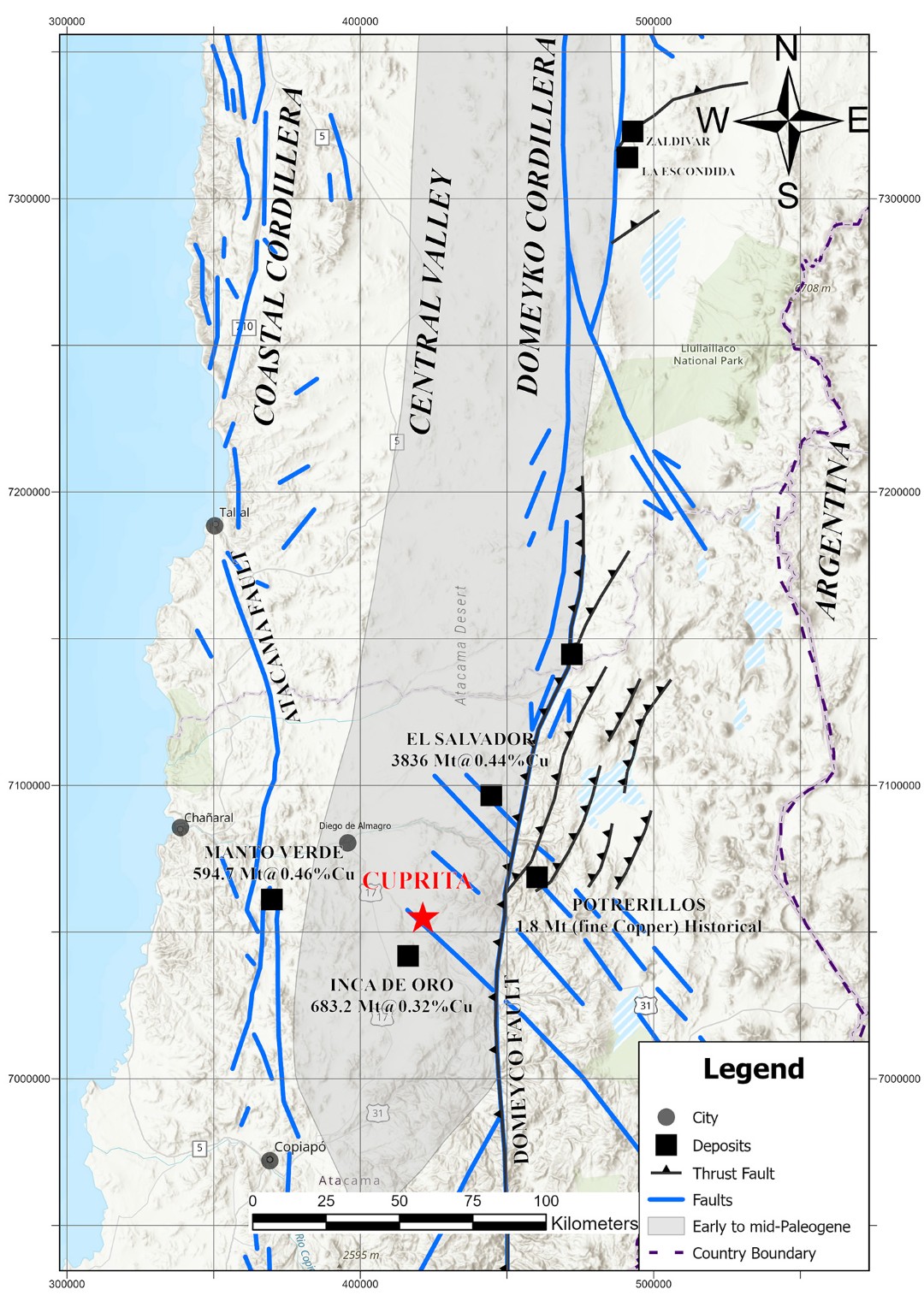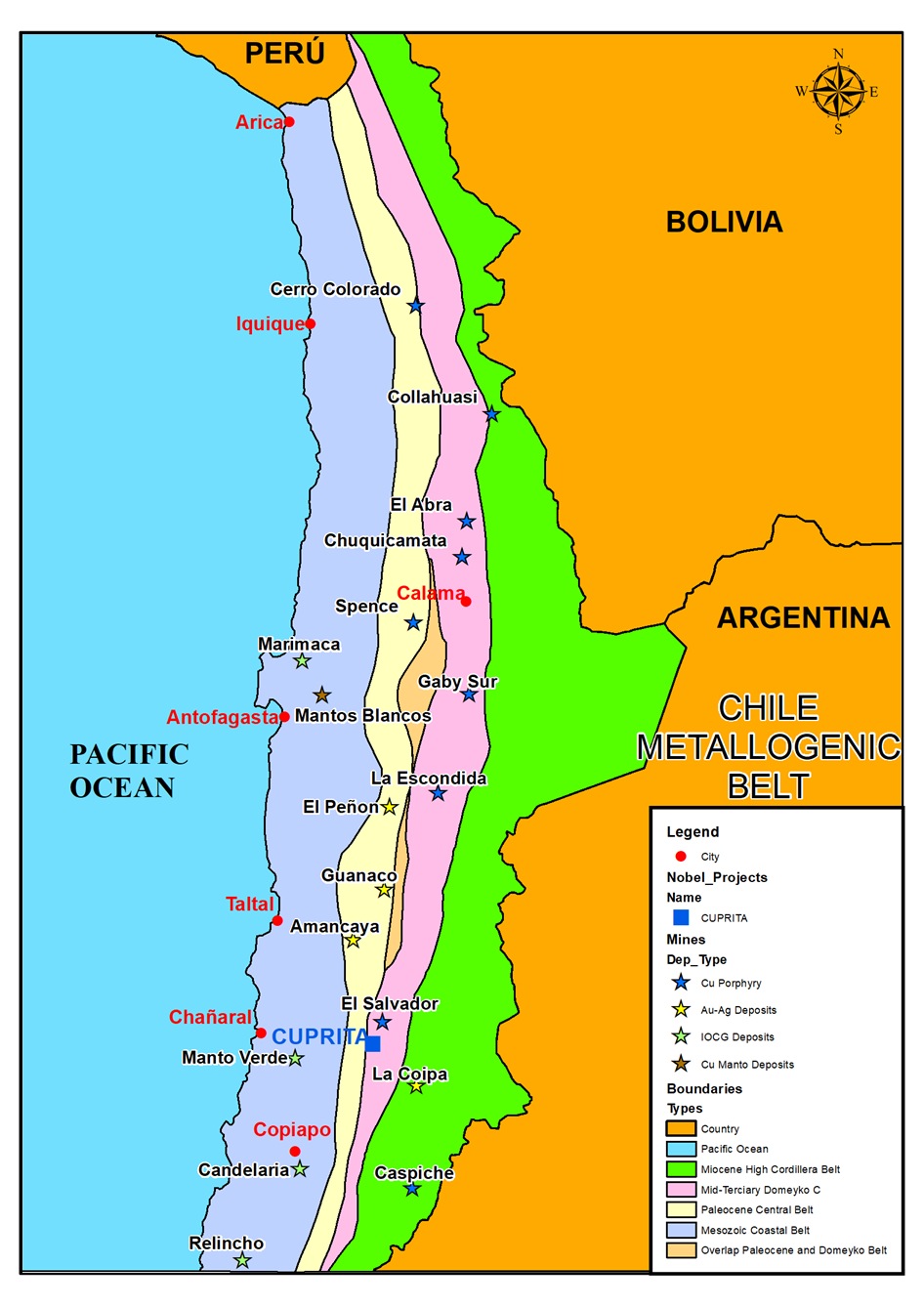The Cuprita Project is Nobel Resources Corp.’s flagship copper exploration asset, strategically located in the world-renowned Paleocene Porphyry Copper Belt of northern Chile. Covering approximately 1,000 hectares, the project sits between two major deposits - El Salvador and Inca de Oro - in a district known for hosting large-scale, low-pyrite porphyry copper systems.
Cuprita exhibits all the hallmarks of a compelling porphyry copper target, including:
- Widespread copper oxide mineralization at surface
- Hydrothermal breccias and quartz-tourmaline vein systems
- Strong geophysical anomalies (Induced Polarization and magnetic lows) that suggest a potentially large, deep-rooted system
Historical exploration - including trenching, rock sampling, and multiple geophysical surveys - has outlined three primary target zones, with copper grades confirmed in surface samples and trenches.
Nobel also holds an 100% option to acquire the Janett, Anais, and Pampa Austral deposits as part of the acquisition of the Cuprita Project. For more information about these projects, click on the link HERE.

Cuprita Regional Geologic Setting

Chile Regional Map - Paleocene Porphyry Copper Belt
Cuprita Project
Location: Tier-1 Jurisdiction with World-Class Copper Endowment
- The Cuprita Project is located in the heart of Chile’s Paleocene Porphyry Copper Belt, one of the most productive copper districts globally, hosting multiple world-class operations.
- The project lies approximately 36 km southeast of Diego de Almagro and 126 km northeast of Copiapó, a major mining services hub.
- Excellent infrastructure access via regional highways, power grid proximity, and nearby ports in Antofagasta and Coquimbo, reducing future development hurdles.
Geology & Mineralization:
- Cuprita displays textbook porphyry copper geological features, including quartz-monzonite intrusions, hydrothermal breccias, and structurally controlled vein systems.
- Mineralization includes widespread copper oxides at surface (atacamite, brochantite, chrysocolla), hosted in fractures, quartz veinlets, and breccia matrices.
- Surface alteration patterns and copper-bearing quartz-tourmaline breccias indicate a low-pyrite porphyry system, similar to nearby deposits such as El Salvador and Inca de Oro.
Exploration Highlights:
- Historical trenching, rock sampling, and geophysics confirm the presence of a large, structurally-controlled mineralized system at Cuprita.
- Three priority targets have been defined with coincident IP chargeability anomalies, magnetic lows, and copper in soils and rocks — none of which have been drilled.
- Geophysical interpretation suggests a deep, intact porphyry system with large-scale potential and excellent vertical continuity.
Strategic Advantages:
Cuprita is located in a mining-centric region with strong logistical and operational advantages:
- Road-accessible via Route C-17 and connected to a grid of provincial highways
- Close to regional power and water infrastructure
- Within trucking distance of multiple deep-sea ports including Antofagasta and Coquimbo
- Nearby skilled workforce and mining services in Diego de Almagro and Copiapó
Future Potential:
- Phase 1 (Underway): Target refinement through detailed mapping, geochemistry, and expansion of geophysical coverage across all anomalies
- Phase 2: Drill program of up to 4,500m of reverse circulation drilling targeting high-priority IP and magnetic anomalies
- Near-term news flow includes expanded sampling results, refined drill targeting, and maiden drilling — all designed to unlock Cuprita’s discovery potential
- Read our Press Release about our option agreement HERE


